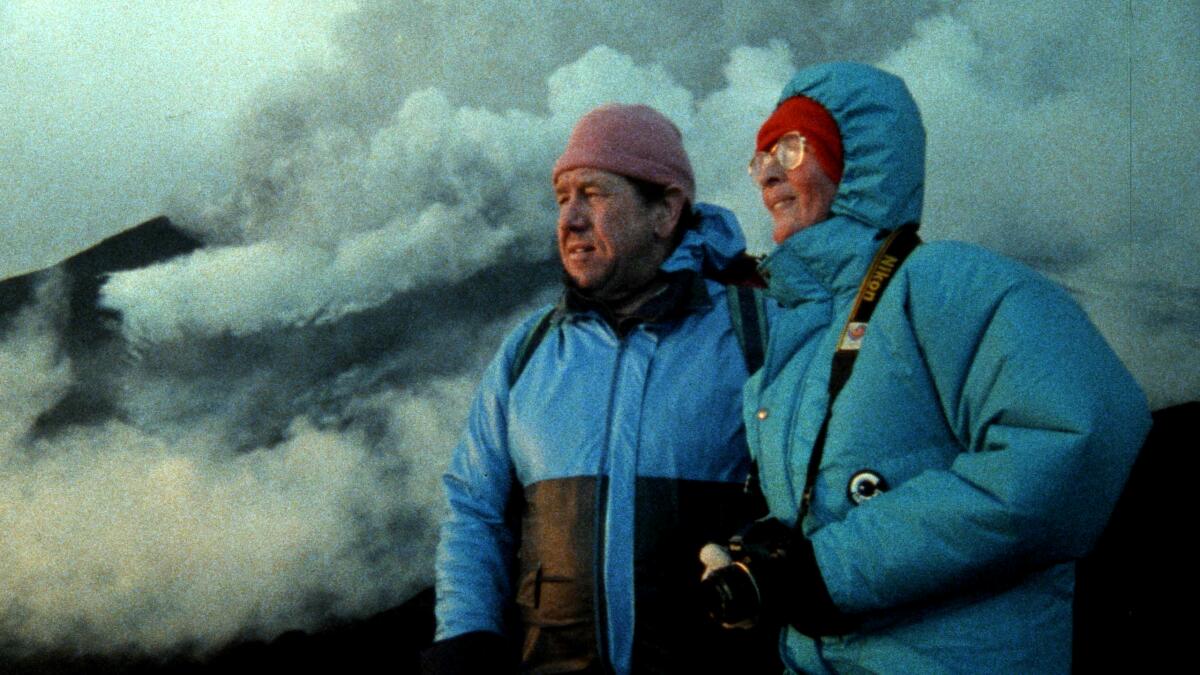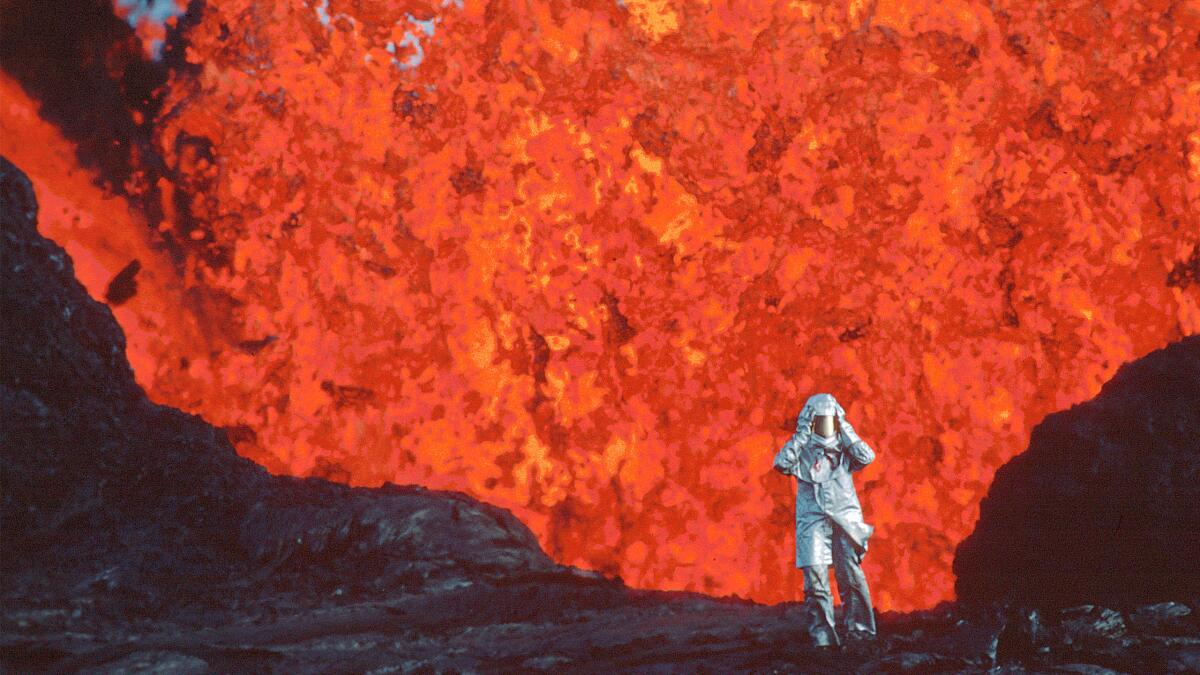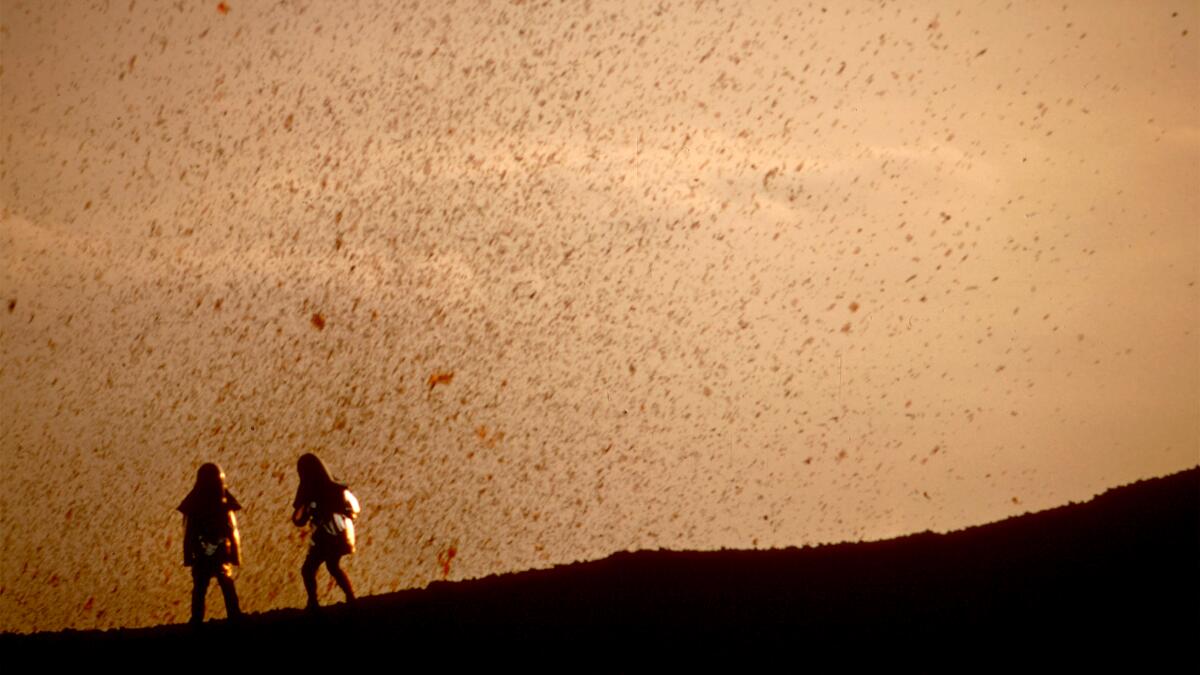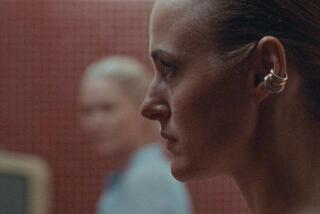Review: As both a doc about volcanoes and a scientists’ romance, ‘Fire of Love’ kicks ash

)
- Share via
The visually entrancing volcano documentary “Fire of Love” chronicles a magnificent obsession and might even make that obsession your own. It didn’t have to work terribly hard in my case. I was already a budding volcanophile when I decided, at age 8, that I’d never seen anything more beautiful than the geysers of lava raining down on Kilauea, a hyperactive Hawaiian monster that I soon declared my favorite volcano in the world. (It was one of several contenders.) I wasn’t much older when I learned that one of Kilauea’s longest recorded eruptions actually started the day I was born, one of those funny coincidences that felt eerily prophetic at the time.
My 8-year-old self, no less than my present-day one, would have thrilled to the majestic images in “Fire of Love,” which deserve to be seen on the biggest screen possible. (The movie is opening in theaters this week; it’ll be available on Disney+ later this year.) The images were filmed by fearless French volcanologists Katia and Maurice Krafft, who pursued their shared passion to the ends (or at least the edges) of the Earth, where the crust fissures and rock slides against molten rock.
Katia, a geochemist, and Maurice, a geologist, met as students in 1966, married in 1970 and spent the rest of their lives visiting active volcanoes all over the world, marching right up to flowing lava rivers and smoking craters and filming what they saw.
For your safety
The Times is committed to reviewing theatrical film releases during the COVID-19 pandemic. Because moviegoing carries risks during this time, we remind readers to follow health and safety guidelines as outlined by the CDC and local health officials.
They are the subjects of this movie and, to a significant degree, its authors. Starting with a gorgeous fire-and-ice prologue in which we see the Kraffts pushing a none-too-reliable truck up a snowy Icelandic mountainside, “Fire of Love” draws on hundreds of hours’ worth of 16-millimeter footage that they shot over more than two decades.
And like a scientist making the most of an incomplete but invaluable fossil record, director Sara Dosa (“The Seer and the Unseen”) forges a clear and absorbing narrative path through the Kraffts’ archive. Her connective tools include Miranda July’s poetic narration, Lucy Munger’s inventive animated segments, Patrice LeBlanc’s meticulous sound design and, above all, Erin Casper and Jocelyne Chaput’s propulsive editing, which won a prize at this year’s Sundance Film Festival. (Casper and Chaput are also credited as writers on the film, along with Dosa and Shane Boris.)
“Fire of Love” thus wants us to see the world and its wonders as Katia and Maurice Krafft saw them, to reap the benefits of their expertise and share in their astonishment. (The emotional swells of Brian Eno’s “The Big Ship” and Ennio Morricone’s “The Ecstasy of Gold” help direct our awe, as does an exquisite score by Nicolas Godin of the French duo Air.)
As its title makes clear, the movie also seeks to cast the Kraffts as well-matched leads in a most unusual love story, one that found its grandest consummation in jaw-dropping eruptions of lava and ash.
“Fire of Love” is sometimes a romantic comedy, predicated on the affable TV-friendly chemistry between the grinning, gregarious Maurice and the petite, birdlike Katia. By the end, when it recounts its subjects’ deaths in the 1991 eruption of Mt. Unzen in Japan, the story has morphed into something more somber, though the Kraffts themselves might have stopped short of calling it a tragedy.

Their lifelong devotion to “a kamikaze existence in the beauty of volcanic things” feels at once radical and strangely familiar, given the recent glut of documentaries about thrill seekers and extreme sports aficionados, like “The Rescue” and “Free Solo.” (Any number of Werner Herzog films come to mind, including his 2016 volcano documentary, “Into the Inferno,” which features a segment on the Kraffts.)
Like some of the subjects of those earlier works, Katia and Maurice chased their calling with the intensity of true believers, as well as an undisguised impatience with anyone or anything else that might make demands of their time.
“We no longer see the world with all its mediocrities,” Katia is heard saying at one point. Her husband shared her view of volcanoes as superior company, a refuge from the tedium of human concerns, but he also possessed a reckless streak that eluded even her.
In one of the film’s more harrowing episodes, shot in Indonesia in 1971, Maurice incurs Katia’s wrath by sailing a rubber dinghy into an enormous lake of highly concentrated sulfuric acid. The footage of that adventure is exquisite and unnerving, especially when the camera pulls back to reveal Maurice and a colleague seated in their vulnerable little craft, wreathed in the toxic mists of a lake that could eat them alive.
Like many other images here — including a shot that finds Katia straddling the edge of a crater, then traces a downward arc into the billowing smoke below — this scene shows compositional elegance and an intuitive sense of visual scale.
Despite this, Maurice at one point states: “I am not a filmmaker. I am a wandering volcanologist forced to make films in order to wander.” That he may have been; to fund their many expeditions, he and Katia mined every possible revenue stream, publishing books of their photographs and touring the lecture circuit. But the visions unleashed in “Fire of Love” suggest that they took their art as seriously as they took their science.

July’s narration works beautifully in concert with the images, often calling our attention to specific details within the frame and questioning the motives and circumstances that might have produced them.
In the absence of conventional talking heads, her thoughtful, melancholy phrasings achieve a lyricism that harks back to a classical tradition of French documentary filmmaking. She’s a good fit for this story, given the wistful romanticism and searching, adventurous spirit of her own work as an actor, artist and filmmaker. She also steers the movie through a crucial tonal and moral transition.
“Volcanoes must destroy to create, but must this unruly cycle take human life?” July asks, articulating the Kraffts’ horror at the death tolls exacted by the eruptions of Mt. St. Helens in 1980 and, especially, Nevado del Ruiz in 1985, which killed more than 20,000 people in Armero, Colombia.
Their subsequent determination to sound the alarm in hot spots around the world, to use their scientific authority and knowledge to save lives, granted new meaning to their own lives and deaths; it also separates Dosa’s film from some of those other docs about nature-loving daredevils.
The fire of Katia and Maurice Krafft’s obsession consumed them, in no small part, because it ultimately restored their kinship with humanity.
‘Fire of Love’
Rating: PG, for thematic material including some unsettling images, and brief smoking
Running time: 1 hour, 33 minutes
Playing: Starts July 6 at AMC Sunset 5, Los Angeles
More to Read
Only good movies
Get the Indie Focus newsletter, Mark Olsen's weekly guide to the world of cinema.
You may occasionally receive promotional content from the Los Angeles Times.











